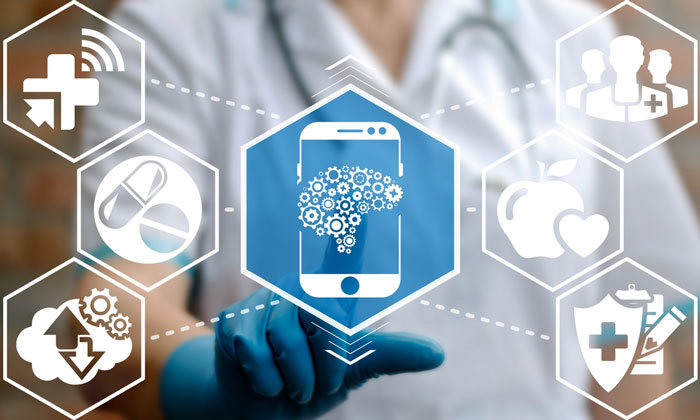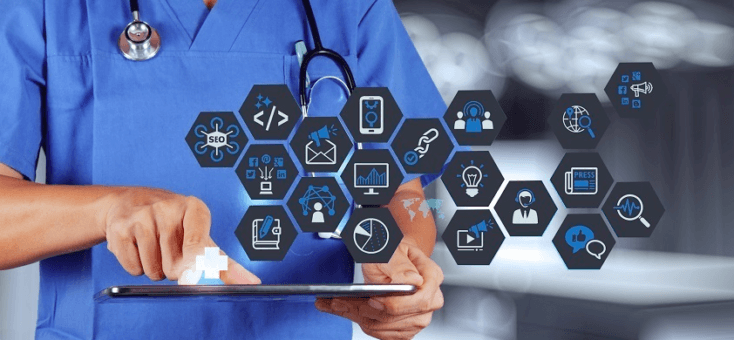
Future of Online Medicine And Internet in Health Care
Fighting to extend human life is one of the most crucial challenges in healthcare innovation. Medical technology will play a significant part in ensuring that we can address the most pressing health challenges we face in the future, which holds great promise for healthcare. As barriers to accessing healthcare services continue to disappear, the growth in linked medical devices occurs at a crucial moment. On the other hand, new healthcare technology enables healthcare experts to advance in their area, treat more victims, and combat novel diseases. In this blog, we’ll discuss the potential of online medicine and the technology in the field of health care.
Medical applications of the Internet of Things

Network connections between medical equipment and patients are becoming commonplace for doctors. Internet of Medical Things (IoMT), a network of related medical equipment, software, health systems and services, is one of the many submarkets that have evolved inside the Internet of Things (IoT). The coupling of internet-connected medical equipment with patient information makes the IoMT ecosystem unique.
Acute medical attention
The queues at emergency rooms have significantly decreased because of IoT advancements. EMTs (Emergency Medication Technicians) who transport patients to hospitals can potentially benefit from the same data. Infrared sensors monitor the hospital’s blood supply and blood type availability in addition to helping with bed availability. An IoT-enabled badge that tracks blood pressure, pulse, body temperature, and respiration rate may be part of the future of emergency medical treatment.
Pharmacy quality assurance

In manufacturing and storage facilities, real-time stock visibility into medications is made possible by IoT sensors, including RFID tags and barcodes. As a result, restocking and medicine fulfilment have improved, and pharmacies have saved a lot of money. By consistently delivering real-time information regarding compliance with quality requirements, the IoT also assists in documenting manufacturing processes assuring precision and excellence.
Procedures for health insurance
Patient data gathered through sensor-based devices, including wearables, biosensors, and mobile apps, is used by IoT applications in the health insurance industry. It also gives health insurance companies the authority to approve virtual visits and telemedicine. Medical insurance providers may more properly assess risks using IoT technology, which helps with underwriting and claims. Blockchain technology, which simplifies underwriting with real-time data, might be used in medical insurance IoT applications in the future. Consequently, there would be no need to draught legal documents, saving money that may be distributed to insurance consumers.
Advancements in Healthcare Technology
-
3D Printing
Each implant may be custom-made for each patient’s body using 3D printing; even bones have been manufactured in this way. Since several colleges are advancing their research on the 3D printing of bionic body parts, it will create a new market for superior prostheses. Additionally, because the technology is simple to decentralise and replicate, advancements may be implemented quickly.
-
Virtual reality
VR is a fantastic way to get a patient ready for surgery. A colonoscopy, for example, might be made to seem a little less terrifying than it is. It can also be used to inform patients about the potential adverse effects of medications. Compared to conventional techniques like cadaver labs or manikin exercises, these reality-enhanced surgical simulators offer excellent training for necessary procedures, which is also true for general healthcare. Additionally, VR has a place in educating medical staff and enhancing patient outcomes.
-
Augmented reality
The medical applications of augmented reality (AR) are astounding. While virtual reality (VR) aims to replace the user’s sensory experience, augmented reality (AR) aims to enhance it, making it possible for data changes to happen more quickly. One can perform complex procedures more safely thanks to the unparalleled access that AR can provide to a patient’s inside organs. AR may minimise the chance of misunderstandings and errors by assisting a practitioner in synthesising several bits of information simultaneously.
-
Chatbots
Chatbots may now assist healthcare practitioners in various ways following recent advancements in natural language processing (NLP) and machine learning (ML). Large databases may be accessed by chatbots, which can then offer helpful information in an informal or chat setting. They can support people with making appointments and respond to patients’ inquiries about symptoms, nutritional information, and other topics. Moreover, chatbots may assist with questions about health insurance, serve as a diagnostic tool, and offer mental health assistance.
5. Genome sequencing
We should not let fear prevent us from recognising how gene technology will improve people’s lives. It is now feasible to print ever-increasing volumes of genetic material and modify genomes more profoundly because of advancements in the technology required to build genetic sequences that are subsequently introduced into bacteria. This may provide information about how viruses propagate or assist in developing vaccines and other therapies. Genome sequencing is becoming more affordable, and genetic consults will soon be commonplace. It’s critical to remember that gene technology may be abused by the powerful, similar to other historical breakthroughs.
-
Robotics
Due to their specialised roles and capacity for performing repeated cognitive activities, robots are ideal for patients undergoing treatment. The nature of surgery is also evolving as a result of robotics technology; robots can now carry out some operations more safely than human surgeons. These autonomous units will redefine hospital and medical treatment worldwide as they become more efficient and affordable.
Management and monitoring
IoT-enabled equipment and methods are necessary for healthcare management. Patient flow management modernises hospital operations by reducing bottlenecks and enhancing the patient experience. For lower inventory expenses and more employee productivity, inventory management simplifies purchasing, storing, and using consumables, medications, medical equipment, and hospital supplies. High-value mobile assets like wheelchairs and infusion pumps are tracked and monitored by asset management across the facility. Without requiring cumbersome equipment or a doctor’s presence, remote monitoring enables continuous monitoring of patients’ development; because of this, everyone has a more pleasant and affordable experience.
Wrapping Up
The driving factors promoting internet use in healthcare are potent and unstoppable. With digital transformation putting technologically advanced and connected goods in users’ hands and improving access to healthcare facilities even for patients and clinicians in the most rural and underdeveloped areas, traditional health care is undergoing a paradigm change. Without question, IoT technology has advanced healthcare by bringing about such ground-breaking advancements. Patients gain from convenience, increased participation, and reduced in-person doctor visits. More accurate data, diagnoses, and time management have benefited providers. More extraordinary developments in healthcare will surely follow in the future, significantly streamlining the medical field for practitioners and patients.
